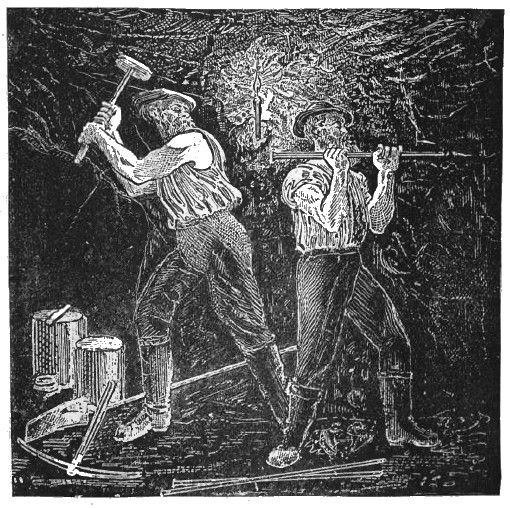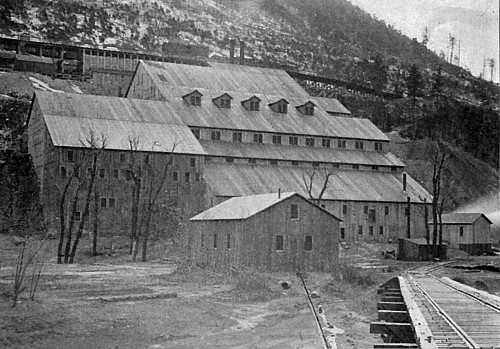Aluminum:
Aluminum is derived from two ores, cryolite and bauxite. This metal has
made rapid strides into favor during the past half-dozen years. Although
known since 1827, it remained a rare substance in the metallic form, though
it is the most abundant of any of the metals in its ore. In ordinary clay
there is an inexhaustible source of aluminum. But the ores that yield the
metal cheaply are few. Until recently, cryolite, found abundantly in
Greenland, was the chief source of the metal, but now bauxite is used in its
place. Bauxite is a limonite iron ore in which a part of the iron has been
replaced by aluminum. It is found in Alabama, Georgia and Arkansas, as well
as in Europe. Aluminum is white, and very light in weight. It does not
tarnish easily. The chemical composition of these ores is:
Aluminum.
Cryolite, Al2F6 .6NaF 12.8 per cent.
Bauxite, A12O3 .3H2O 73.9 per cent.
In 1895 the production of this metal in the United States was 900,000 pounds. In 1899 had risen to 6,500,000 pounds. The only firm producing aluminum is the Pittsburg Manufacturing Company of Buffalo, N. Y. who reduce the metal from bauxite, which they obtain in the southern states. One of the latest uses for this metal is for gold miners' pans. The French seem to keep ahead of the rest of the world in finding new uses for aluminum. Most of the supply of cryolite comes from "Greenland, where it occurs in veins running through gneiss rocks. Glass-makers use it and pay good prices for it. Lately makers of aluminum also buy it, as it contains 13 per cent, of that metal. A new aluminum-bearing mineral, discovered in New Mexico and in Ohio, is called native alum. It gives 50.16 per cent, alumina, and may be treated by solution in warm water, filtration, evaporation and roasting. No estimate has yet been made of the amount available.
As bauxite promises to be in greater demand in the future than in the present, owing to the ever-increasing demand for aluminum, the prospector will do well to make himself thoroughly familiar with its appearance. It is creamy white when free from iron, and the grains are like little peas, or pisolitic. It contains water, aluminum, silica, and generally iron. The French beds near the town of Baux are 30 miles long and 40 feet thick. In the United States, beds have been found in Alabama, Georgia and Arkansas. The Georgia beds are turning out three-fifths of the bauxite produced in America. The ore is in beds and pockets, and enough has been prospected to assure a supply for some years to come, unless the demand should grow very decidedly, in which case a scarcity might soon be felt. The American ore is easier to work than the French, and manufacturers prefer it to any they can import, even though the cost is higher and the percentage of aluminum smaller. The Arkansas deposits are as thick as the French, and only 300 feet above the level of the tide. Imported bauxite cost $5 to $7 a ton in New York City. American ore costs $5 to $12 a long ton. Best selected Georgia brings $10. Should the deposits of bauxite give out, the manufacturers of aluminum would probably fall back on cryolite. At Tvigtuk, on the west coast of Greenland, it exists, as a very heavy vein, in gneiss. It is semitransparent, and snow-white. Impurities may stain it yellow or red or even black. Its specific gravity is 2.95, and its hardness 2.5 to 3. It is fusible in the flame of a candle, and yields hydrofluoric acid if treated with sulfuric acid. It is still used for making soda and aluminum salts, and an imitation porcelain. It is also in general use as a flux.
Chromium:
All chrome is obtained from
chromite, which contains 68 per cent, of chrome sesquioxide, the
remainder being iron protoxide. Hardness, 5.5; gravity, 4.4 ; luster,
sub-metallic ; opaque. Steel-gray to almost black. Harsh. Brittle. Cleavage,
imperfect. Fracture, uneven. Texture, massive to granular. Chromite in
gravel looks like shot. Serpentine often contains it, when it is apt to
resemble a fine-grained
magnetite. It is used chiefly in iron and steel alloys, and
in making armor plate. It is also used in dyeing fabrics and in paint
manufacture. But little chrome ore is produced in the United States.
Chromite, FeOCr2O3 47-68 This ore is merchantable at $22 to $25 per ton.
Domestic ore ranges from $10 to $12 a ton, while the pure imported ores are
worth $21 a ton. The yearly consumption in the United States is about 16,000
tons, and the American production 100 tons. This ore is useful as a lining
for furnaces, and the demand promises to become important. Newfoundland is
said to contain large deposits.
Iron:
This, the most important of all metals, is found in various forms. The
ores of iron are:
Sp. Gravity. Hardness. P C. Fe.
Native iron ore 7.7
4.5
100
Magnetite 5.1
6.0
72
Hematite
4.8
6.0
70
Limonite
3.8
5.2
60
Siderite
3.8
4.0
62
Pyrite
5.0
6.3
47
Native iron is only found in meteorites that have come from space. Magnetite is loadstone ore; the powder is reddish black, and the ore, dark brown to black. It is found in the older rocks and is an important ore. Hematite varies from metallic to dull in luster. There are many varieties of it, known as ironstone, ocher, needle ore, etc. Hematite may be slightly magnetic. Immense beds exist in the triassic sandstones, and in the secondary rocks below the coal measures. The powder and streak of limonite are always yellow; it is an important ore. siderite assumes many forms. It is called spathic ore, clay-ironstone, carbonate of iron, black band, etc. Most of these carbonate iron ores only range between 30 and 40 per cent of metallic iron, but are in demand as fluxes for other iron ores. ,The pyritic ores of iron, including marcasite, pyrrhotite and mispickel, are often taken for gold by the inexperienced. In an accessible region pyrites may be valuable, as they are bought by makers of sulfuric acid.
Iron is so low in price that vast deposits exist which cannot be made use of because they would be too expensive to mine. A deep bed, or a narrow one, or the slightest difficulty in transportation, would preclude any profitable development. It is known that enormous areas in northern Labrador, for instance, are full of iron deposits, yet there seems no chance of their having the slightest economic value for a long time, if ever. Conditions of commerce very different to those now obtaining will have to exist before they can be utilized. Iron ore is most favorably situated for profitable extraction when it is near coking coal and beds of limestone; the former for fuel, the latter for flux. Occasionally such regions as that of Lake Superior may be able to compete successfully with others, although they do not possess the necessary smelting facilities, because these deficiencies are counterbalanced by seemingly inexhaustible stores of easily mined ores, and transportation facilities unrivaled in cheapness.
Continue on to:
Identifying Ores of Antimony, Mercury, Nickel, Platinum, Tin & Zinc
Return To:
Gold And Silver Basic Prospecting Methods


